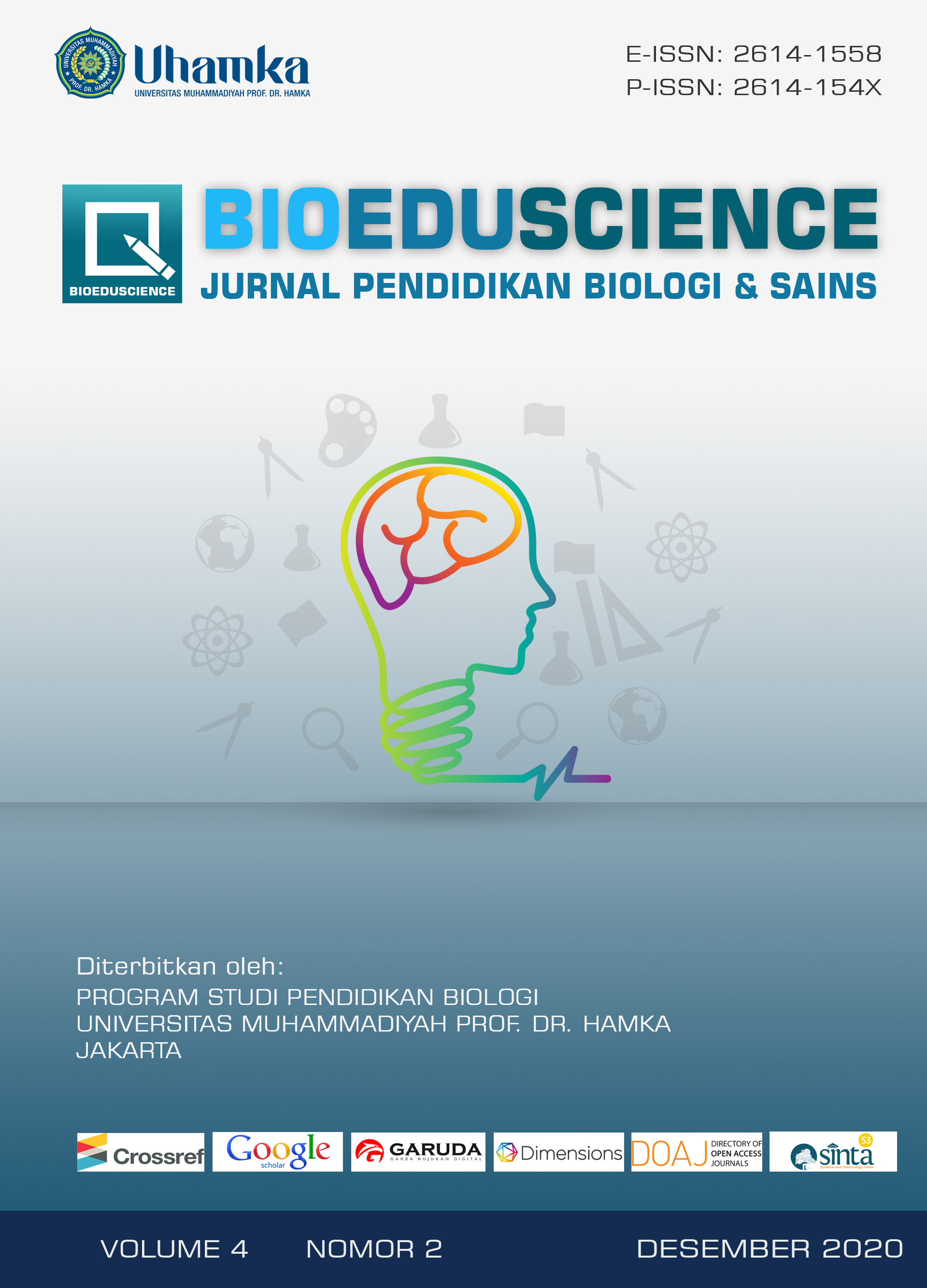Analysis of molecular interactions of 8-gingerol compounds in Ginger (Zingiber officinale) as ACE Inhibitor
Abstract
Background: Hypertension is a disease with increasing characteristics of blood pressure. The ACE gene has a role in the conversion of ATI to ATII in hypertensive conditions. Healing is done by using the 8-gingerol content contained in ginger. The purpose of this study is to analyze the molecular interaction that occurs between 8-gingerol and ACE. Method: ACE model proteins (ID: 3bkk) were obtained from the Bank Data Protein database (PDB) through 8-gingerol ligands (CID: 168114) obtained from the PubChem database. ACE and 8-gingerol were docked by Discovery Study Client 4.1 software. Analysis of amino acid residues, binding energy, Van der Waals forces, and hydrogen bonds formed using Discovery Studio Client 4.1. Results: The interaction between 8-gingerol and ACE showed that there were seven amino acid residues that interacted with 8-gingerol, also found hydrogen bonds, hydrophobic and Van der Waals forces that strengthen and stabilize these bonds. Conclusion: the interaction of 8-ginger with the active side of ACE is determined as an ACE inhibitor, the inhibition is a significant effect on the obstruction of ACE conversion.
Full text article
References
Arun, K. B., Dhanya, R., Chandran, J., Abraham, B., Satyan, S., & Nisha, P. (2020). A comparative study to elucidate the biological activities of crude extracts from rice bran and wheat bran in cell line models. Journal of Food Science and Technology. https://doi.org/10.1007/s13197-020-04353-1
Bare, Y., Marhendra, A., Sasase, T., & Fatchiyah, F. (2018). Differential Expression of IL-10 Gene and Protein in Target Tissues of Rattus Norvegicus Strain Wistar Model Type 2 Diabetes Mellitus (T2DM). Acta Informatica Medica, 26(2), 87. https://doi.org/10.5455/aim.2018.26.87-92
Bare, Y., Maulidi, A., Sari, D. R. T., & Tiring, S. S. N. D. (2019). Studi in Silico Prediksi Potensi 6-Gingerol sebagai inhibitor c-Jun N-terminal kinases (JNK). Jurnal Jejaring Matematika dan Sains, 1(2), 59–63. https://doi.org/10.36873/jjms.v1i2.211
Bare, Y., S, M., Tiring, S. S. N. D., Sari, D. R. T., & Maulidi, A. (2020). Virtual Screening: Prediksi potensi 8-shogaol terhadap c-Jun N-Terminal Kinase (JNK). Jurnal Penelitian Dan Pengkajian Ilmu Pendidikan: E-Saintika, 4(1), 1–6. https://doi.org/10.36312/e-saintika.v4i1.157
Bare, Y., Sari, D. R. T., Rachmad, Y. T., Krisnamurti, G. C., & Elizabeth, A. (2019). In Silico Insight the Prediction of Chlorogenic Acid in Coffee through Cyclooxygenase-2 (COX2) Interaction. Biogenesis: Jurnal Ilmiah Biologi, 7(2). https://doi.org/10.24252/bio.v7i2.9847
Bhullar, K. S., Lassalle-Claux, G., Touaibia, M., & Rupasinghe, H. P. V. (2014). Antihypertensive effect of caffeic acid and its analogs through dual renin–angiotensin–aldosterone system inhibition. European Journal of Pharmacology, 730, 125–132. https://doi.org/10.1016/j.ejphar.2014.02.038
Chobanian, A. V. (2004). Penyakit hipertensi dapat meningkatkan risiko terjadinya penyakit kardiovaskular. NIH Publication.
Dharmeizar. (2012). Hipertensi. Medicinus: Scientific Journal of Pharmaceutical Development and Medical Application, 25(01), 03–08.
Dipiro, J. T., Talbert, R. L., Yee, G. C., Matzke, G. R., Wells, B. G., & Posey, L. M. (2017). Pharmacotherapy: A Pathophysiologic Approach, 10e. McGraw-Hill Education.
Efferth, T., & Koch, E. (2010). Complex Interactions between Phytochemicals. The Multi-Target Therapeutic Concept of Phytotherapy. Current Drug Targets, 12(1), 122–132. https://doi.org/10.2174/138945011793591626
Ghasemzadeh, A., Jaafar, H., Baghdadi, A., & Tayebi-Meigooni, A. (2018). Formation of 6-, 8- and 10-Shogaol in Ginger through Application of Different Drying Methods: Altered Antioxidant and Antimicrobial Activity. Molecules, 23(7), 1646. https://doi.org/10.3390/molecules23071646
Kataria, R., & Khatkar, A. (2019). In-silico design, synthesis, ADMET studies and biological evaluation of novel derivatives of Chlorogenic acid against Urease protein and H. Pylori bacterium. BMC Chemistry, 13(1). https://doi.org/10.1186/s13065-019-0556-0
Mao, Q.-Q., Xu, X.-Y., Cao, S.-Y., Gan, R.-Y., Corke, H., Beta, T., & Li, H.-B. (2019). Bioactive Compounds and Bioactivities of Ginger (Zingiber officinale Roscoe). Foods, 8(6), 185. https://doi.org/10.3390/foods8060185
Ouwerkerk, W., Voors, A. A., Anker, S. D., Cleland, J. G., Dickstein, K., Filippatos, G., van der Harst, P., Hillege, H. L., Lang, C. C., ter Maaten, J. M., Ng, L. L., Ponikowski, P., Samani, N. J., van Veldhuisen, D. J., Zannad, F., Metra, M., & Zwinderman, A. H. (2017). Determinants and clinical outcome of uptitration of ACE-inhibitors and beta-blockers in patients with heart failure: A prospective European study. European Heart Journal, 38(24), 1883–1890. https://doi.org/10.1093/eurheartj/ehx026
Phan, M. A. T., Paterson, J., Bucknall, M., & Arcot, J. (2018). Interactions between phytochemicals from fruits and vegetables: Effects on bioactivities and bioavailability. Critical Reviews in Food Science and Nutrition, 58(8), 1310–1329. https://doi.org/10.1080/10408398.2016.1254595
Primiani, C. N., Lestari, U., Amin, M., & Sumitro, S. B. (2014). Comparative study of effects daidzein contained in yam tuber Pachyrhizus erosus and pure daidzein: The dynamics of chemical compounds and its potential in myometrium. Journal of Biological Researches, 18(2), 1–7. https://doi.org/10.23869/bphjbr.18.2.201310
Sahoo, N., Manchikanti, P., & Dey, S. (2010). Herbal drugs: Standards and regulation. Fitoterapia, 81(6), 462–471. https://doi.org/10.1016/j.fitote.2010.02.001
Shahrajabian, M. H., Sun, W., & Cheng, Q. (2019). Clinical aspects and health benefits of ginger (Zingiber officinale) in both traditional Chinese medicine and modern industry. Acta Agriculturae Scandinavica Section B: Soil and Plant Science, 69(6), 546–556. https://doi.org/10.1080/09064710.2019.1606930
Tarigan, A. R., Lubis, Z., & Syarifah, S. (2018). Pengaruh Pengetahuan, Sikap Dan Dukungan Keluarga Terhadap Diet Hipertensi Di Desa Hulu Kecamatan Pancur Batu Tahun 2016. Jurnal Kesehatan, 11(1), 9–17. https://doi.org/10.24252/kesehatan.v11i1.5107
Tiring, S. S. N. D., Bare, Y., Maulidi, A., S, M., & Nugraha, F. A. D. (2019). Studi In Silico: Prediksi Potensi 6-shogaol dalam Zingiber officinale sebagai Inhibitor JNK. Al-Kimia, 7(2). https://doi.org/10.24252/al-kimia.v7i2.10638
Van Breda, S. G. J., Briedé, J. J., & de Kok, T. M. C. M. (2019). Improved preventive effects of combined bioactive compounds present in different blueberry varieties as compared to single phytochemicals. Nutrients, 11(1). https://doi.org/10.3390/nu11010061
Authors

This work is licensed under a Creative Commons Attribution 4.0 International License.

